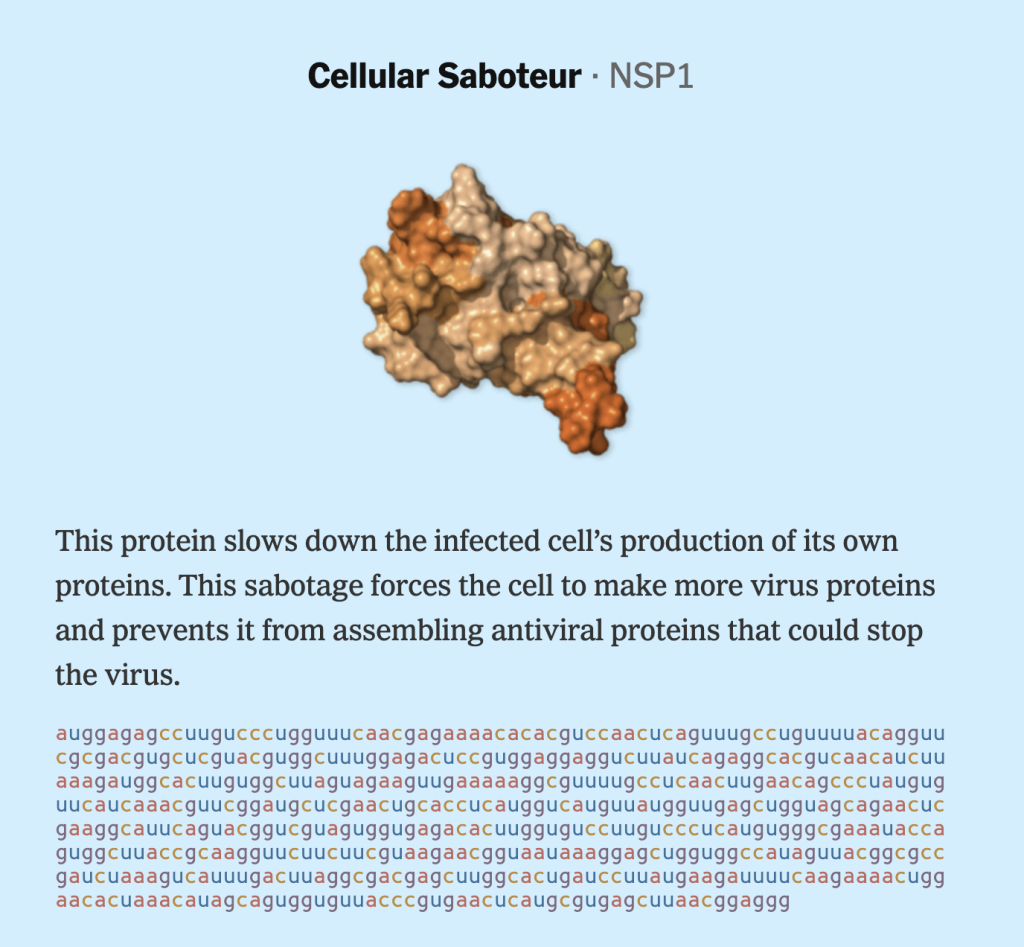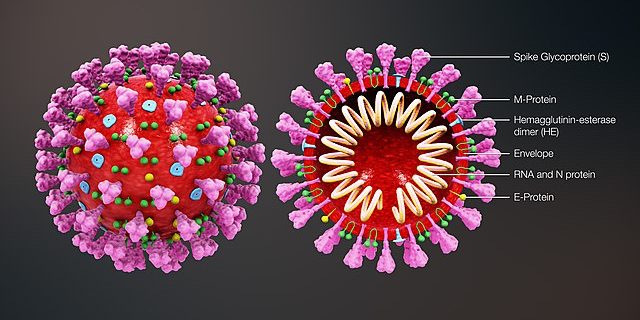Lately, there has been coverage about the second wave of COVID-19 coming this fall and winter. This news can be frightening but it is important to remember how much has been learned in just the last four months about this virus. I took heart first, in an article which describes the entire virus and its proteins.
Viral Genome Described
The New York Times published a fascinating article on April 3 called, “Bad News Wrapped in Protein: Inside the Coronavirus Genome.” It is hard to believe that this amount of detail is present in a newspaper article.  This image is of one of the many proteins the article describes. Below that, a description of what it does and finally, the actual sequence of neucleotides that are used by the virus to create the protein. The entire NYTimes article is filled with the nuts and bolts of this virus.
This image is of one of the many proteins the article describes. Below that, a description of what it does and finally, the actual sequence of neucleotides that are used by the virus to create the protein. The entire NYTimes article is filled with the nuts and bolts of this virus.
For someone who was alive in 1977, when for the first time Frederick Sanger came up with a technique for determining the actual sequence of nucleotide bases, for a virus, this description amazes me. At that time, it would have taken months and months of lab work to get the sequencing right.
Now genomics, and computers, have evolved to be able to quickly obtain the sequence of a virus. In fact, on January 24, 2020 the Pasteur Institute obtained samples of the novel coronavirus from Chinese officials and by January 30, the complete sequence was published.
Targets for treatment
Because of this information, we have learned about targets for treatment of this virus. For example, there are two things that a virus needs to enter a cell. First it needs a receptor on the cell membrane. Then it needs a protease – an enzyme that breaks down proteins.
On the outside of the SARS-COV-2 or coronavirus are protrusions that give the coronavirus its name. These protrusions are made by groups of three “S” proteins also called “Spike” proteins. It has been discovered that the S protein of the virus binds with a human ACE2 receptor protein molecule on the membrane of a human cell. Then the TMPRSS2 protein enzyme that is part of the human cell’s surface cleaves or breaks up the S viral protein in a process that is also called priming. In this way, the RNA of the virus enters the cell membrane. From there, it produces a host of other proteins that take over the cell and produce more viruses.
by groups of three “S” proteins also called “Spike” proteins. It has been discovered that the S protein of the virus binds with a human ACE2 receptor protein molecule on the membrane of a human cell. Then the TMPRSS2 protein enzyme that is part of the human cell’s surface cleaves or breaks up the S viral protein in a process that is also called priming. In this way, the RNA of the virus enters the cell membrane. From there, it produces a host of other proteins that take over the cell and produce more viruses.
Researchers have been looking for the cells of the body that are most vulnerable because they have high amounts of these “entry proteins” on their surfaces. Two types of cells in the nose (goblet cells and ciliated cells) have been identified. Other places where these entry proteins are expressed on cell surfaces are cells in the cornea of the eye and in the intestinal lining.
Because we know the proteins and the cells that are most at risk, we have valuable information that can be used to find treatments. In just one study that I read, this TMPRSS2 protein enzyme is already being suggested as a target for medication. In fact, in Japan, a compound, camostat meslyate, that has been approved for the treatment of an all-together different condition, could be used to block TMPRSS2 activity. The study authors propose using it “off-label” for people infected by COVID-19.
So don’t get discouraged
There may be scary news in the world but there is also incredible news. That news is that enormous progress has been made, in a very short amount of time, to learn about this virus. Keep safe and stay hopeful. We’ll get through this together.
Feature Image: WikiCommons https://www.scientificanimations.com/wiki-images/Authorhttps://www.scientificanimations.com






